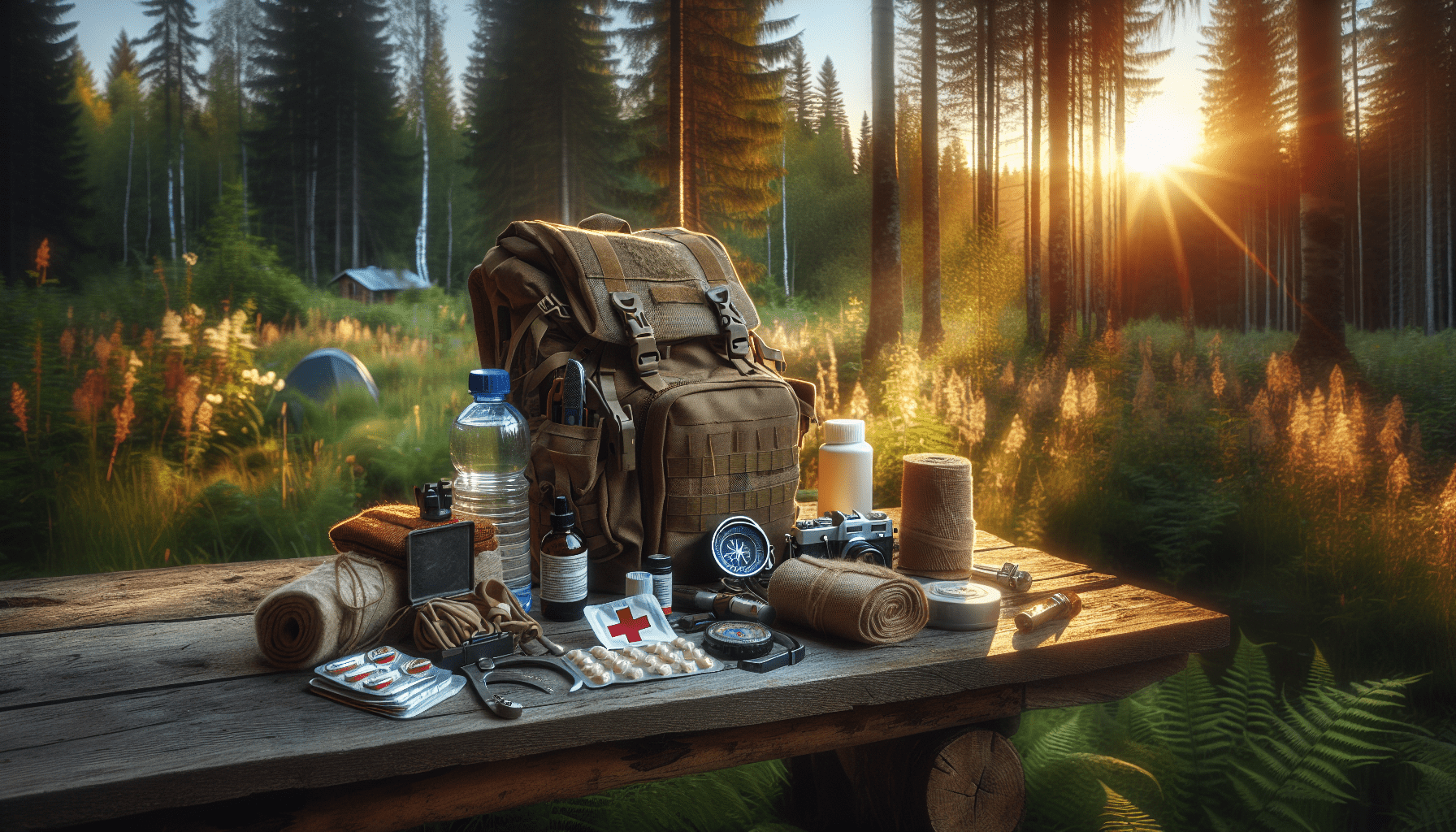You’re in the middle of a beautiful forest, experiencing the serenity of nature. But suddenly, you slip on a slippery rock and sprain your ankle. Or maybe you accidentally brush against a poisonous plant and develop a painful rash. In these unexpected moments, knowing how to treat common wilderness injuries can be crucial. From minor cuts and bruises to more serious burns and fractures, this article will guide you through essential first aid techniques to ensure a safe and enjoyable outdoor adventure. So, before you embark on your next wilderness excursion, make sure to equip yourself with the knowledge to handle any bumps, scrapes, or stings that may come your way.

Cuts and Scrapes
Cuts and scrapes are common injuries that can occur when exploring the wilderness. The first step in treating these wounds is to clean them thoroughly. Begin by rinsing the wound with clean water to remove any dirt or debris. It’s important to avoid using soap as it can further irritate the injury. After cleaning the wound, apply gentle pressure to stop any bleeding. You can use a clean cloth or sterile gauze pad to apply the pressure.
Once the bleeding has subsided, it’s important to cover the cut or scrape to protect it from further dirt or bacteria. Using a sterile adhesive bandage or dressing, carefully cover the wound. Make sure the dressing is large enough to fully cover the injured area and secure it in place.
To promote healing, it is necessary to change the dressing regularly. This helps to keep the wound clean and reduces the risk of infection. Depending on the severity of the injury, you may need to change the dressing daily or more frequently if it becomes dirty or wet. Remember to always wash your hands before and after changing the dressing to minimize the risk of introducing any additional bacteria.
Sprains and Strains
Sprains and strains can occur when participating in outdoor activities that involve sudden movements or overexertion. If you have sprained or strained a body part, the first step in treatment is to rest the injured area. This means avoiding any activities that put additional strain on the injured body part. By allowing it to rest, you give the body a chance to heal itself.
Applying ice or a cold compress to the injured area can help reduce swelling and pain. Wrap an ice pack or a bag of ice in a thin cloth and apply it to the sprained or strained area for about 15 to 20 minutes at a time. This can be done several times a day, but make sure to give your skin breaks between applications to prevent frostbite.
In addition to using ice, you can also compress the injured area to further reduce swelling. Use an elastic wrap or bandage to gently bind the area. Be careful not to wrap it too tightly as this can restrict blood flow. Additionally, elevate the injured limb to reduce swelling. Prop it up on pillows or cushions to help promote blood flow away from the injury.
Over-the-counter pain medication, such as ibuprofen or acetaminophen, can help alleviate pain and reduce inflammation. Follow the instructions on the packaging and consult with a healthcare professional if you have any concerns or preexisting conditions.
Fractures and Broken Bones
Fractures and broken bones can be serious injuries that require immediate medical attention. However, there are some initial steps you can take to stabilize the limb and alleviate pain while waiting for medical help to arrive.
If you suspect a fracture or broken bone, it is essential to stabilize the limb. You can use a splint or any rigid object, such as a board or a rolled-up magazine, to immobilize the injured area. Carefully place the splint on the injured limb, making sure it extends beyond the joints above and below the suspected fracture site. Secure the splint in place using bandages or cloth strips, but be cautious not to apply too much pressure.
Similar to sprains and strains, applying ice or a cold compress can help reduce pain and swelling. Place a cloth or towel between the ice pack and the skin to prevent direct contact, and apply it to the injured area for short intervals, allowing breaks to prevent frostbite.
It is crucial to seek medical attention as soon as possible for fractures and broken bones. Professional evaluation and treatment are necessary to ensure proper healing and to prevent any potential complications. Avoid attempting to reset or manipulate the broken bone yourself, as this can lead to further damage or injury.
Burns
Accidental burns are another common risk when spending time in the wilderness. Whether it’s from a campfire, cooking equipment, or other sources of heat, knowing how to treat burns is important.
The first step in treating a burn is to remove the source of heat. This could involve extinguishing a flame or moving away from a hot surface. Once the source is eliminated, you can begin cooling the burn with running water. Hold the affected area under cool, not cold, running water for at least 10 to 20 minutes. Do not use ice or ice-cold water, as this can potentially damage the burned tissue.
After cooling the burn, it’s important to cover it with a clean cloth or dressing. This helps protect the wound from infection and further damage. Avoid using adhesive bandages directly on a burn, as they can stick to the wound and cause unnecessary pain during removal.
Taking over-the-counter pain medication, such as ibuprofen or acetaminophen, can help relieve burn pain and inflammation. Follow the instructions on the packaging and consult a healthcare professional if you have any concerns or preexisting conditions.
For severe burns, it is essential to seek immediate medical attention. Severe burns can cause significant tissue damage and may require specialized treatment to prevent infection and promote healing.

Heat Exhaustion
Heat exhaustion is a condition that can occur when the body overheats due to exposure to high temperatures and inadequate fluid intake. If you or someone around you is experiencing symptoms of heat exhaustion, it’s crucial to take immediate action.
The first step is to move to a cool and shaded area. This helps to reduce the body’s exposure to heat and provides relief from direct sun exposure. Resting in a shaded area allows the body to cool down more quickly.
Drinking plenty of fluids is essential to rehydrate the body and replenish lost electrolytes. Water is the best choice, but if available, sports drinks or electrolyte solutions can also be beneficial. Avoid alcoholic beverages and caffeinated drinks, as they can contribute to dehydration.
Applying cool compresses to the neck or other pulse points can aid in cooling the body. These areas allow heat to escape more efficiently. Soaking a cloth in cool water and gently applying it to the skin can provide relief from the heat.
If possible, remove any excess clothing to help the body cool down more effectively. Loose-fitting clothing made of lightweight and breathable materials is ideal for promoting airflow and regulating body temperature.
If symptoms of heat exhaustion worsen or do not improve within a reasonable amount of time, it is crucial to seek medical attention. Heat exhaustion can progress to more severe conditions, such as heatstroke, which require immediate medical intervention.
Hypothermia
Hypothermia is a serious condition that occurs when the body loses heat faster than it can produce it, leading to a dangerously low core body temperature. If you or someone you’re with is experiencing symptoms of hypothermia, it’s important to act quickly to prevent further complications.
The first step in treating hypothermia is to get out of the cold and into shelter. Find a warm and protected area away from wind or moisture. If possible, seek indoor shelter or create a makeshift shelter using blankets or materials that help retain body heat.
Remove any wet clothing and replace it with dry layers. Wet clothing can exacerbate heat loss and increase the risk of hypothermia. Dry clothing acts as insulation, helping to retain body heat.
Wrap the affected person in blankets or use a sleeping bag to provide additional insulation. Adding layers of insulation helps trap body heat and warm the individual. If using blankets, make sure to cover the head and neck area as well.
Encourage the person to drink warm liquids to help raise their core body temperature. Warm beverages such as hot water, herbal tea, or warm soup can provide warmth from the inside out. Avoid alcoholic beverages, as they can interfere with the body’s ability to regulate temperature.
If the person’s core body temperature does not rise or if they become unresponsive, it is crucial to seek immediate medical attention. Severe hypothermia can be life-threatening, and professional medical assistance is necessary.

Insect Bites and Stings
Insect bites and stings are an unfortunate part of spending time in the wilderness. Whether it’s mosquitos, bees, or other biting insects, knowing how to treat these irritations is essential for a comfortable outdoor experience.
If a stinger is present, carefully remove it to prevent further venom injection. Use a pair of tweezers or scrape it off gently with a credit card or other flat object. Avoid using tweezers or fingers to squeeze the stinger, as this can release more venom.
Cleaning the area with soap and water is important in preventing infection. Gently wash the affected area to remove any dirt or bacteria that may have been introduced by the insect bite or sting. Pat the area dry with a clean cloth or towel.
To reduce swelling and pain, apply a cold compress to the affected area. This can help constrict blood vessels and alleviate discomfort. You can make a cold compress by wrapping ice or a bag of frozen vegetables in a thin cloth and applying it to the bite or sting for short intervals.
Over-the-counter antihistamines or pain relievers, such as diphenhydramine or ibuprofen, can help alleviate itching, swelling, and pain associated with insect bites and stings. Follow the instructions on the packaging and consult with a healthcare professional if you have any concerns or preexisting conditions.
Snake Bites
Encountering a snake bite while in the wilderness can be a frightening experience. It’s crucial to stay calm and take immediate action to minimize the effects of the venom and seek medical help as soon as possible.
Keeping calm and still can help slow down the spread of venom throughout the body. Avoid panicking or making sudden movements that can increase blood flow and the venom’s reach. Staying as still as possible can help prevent additional toxin absorption.
Clean the bite wound with soap and water to reduce the risk of infection. Gently wash the area and remove any dirt or debris that may be present. Pat the area dry with a clean cloth or towel.
Remove any tight clothing or jewelry near the bitten limb. Swelling can occur, and these items can become restrictive, potentially causing further complications.
Immobilize the bitten limb to reduce movement and prevent the venom from spreading. Use a splint or any rigid object to keep the limb still. Secure the splint in place with bandages or cloth strips, but avoid applying too much pressure.
It is essential to seek immediate medical attention for snake bites. Professional evaluation and treatment are necessary to administer antivenom and prevent any potential complications.

Poisonous Plant Exposure
Exposure to poisonous plants can result in skin irritation, itching, and rashes. If you come into contact with poisonous plants while in the wilderness, there are steps you can take to relieve symptoms and minimize the effects of the exposure.
Wash the affected area with soap and water as soon as possible. This removes any plant oils or residue that may be present on the skin and helps prevent further spreading of the irritants. Gently lather the area and rinse thoroughly.
Applying a cool compress to the affected area can provide relief from itching and reduce swelling. The cool temperature helps constrict blood vessels and soothe irritation. Soak a cloth in cool water and gently apply it to the affected area for short intervals.
Over-the-counter antihistamines or corticosteroid creams can further alleviate itching and reduce inflammation caused by exposure to poisonous plants. Follow the instructions on the packaging and consult with a healthcare professional if you have any concerns or preexisting conditions.
Avoid scratching the affected area, as this can worsen the symptoms and potentially lead to infection. If necessary, cover the area with loose clothing or a clean cloth to prevent further irritation.
Dehydration
Dehydration is a serious condition that can occur when the body loses more fluids than it takes in. When spending time in the wilderness, it’s important to stay hydrated to prevent dehydration.
Drinking plenty of fluids throughout the day is essential for preventing dehydration. Water is the best choice, but if available, electrolyte-rich beverages such as sports drinks can be beneficial. It’s important to avoid beverages such as alcohol and caffeine, as they can contribute to dehydration.
Resting in shaded areas or seeking shelter from direct sunlight can help prevent excessive fluid loss through sweating. Taking breaks in cool areas can also provide relief and help regulate body temperature.
During breaks, it’s important to cool down and allow the body to rest. Find a shaded area or create shade using a portable sunshade or tarp. Remove excess clothing to promote airflow and allow the body to cool down more effectively.
Severe dehydration requires medical attention. If symptoms such as extreme thirst, dizziness, confusion, or decreased urine output occur, it’s crucial to seek immediate medical help. Intravenous fluids may be necessary to rehydrate the body and prevent further complications.
By following these guidelines, you can be better prepared to treat common wilderness injuries. Remember to stay vigilant, take appropriate precautions, and always prioritize safety when exploring the great outdoors.

